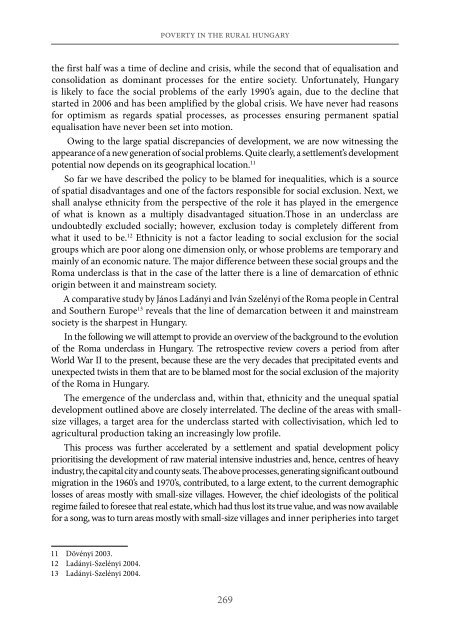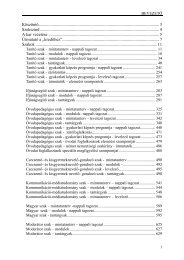ACTA SZEKSZARDIENSIUM - Pécsi Tudományegyetem Illyés Gyula ...
ACTA SZEKSZARDIENSIUM - Pécsi Tudományegyetem Illyés Gyula ...
ACTA SZEKSZARDIENSIUM - Pécsi Tudományegyetem Illyés Gyula ...
Create successful ePaper yourself
Turn your PDF publications into a flip-book with our unique Google optimized e-Paper software.
poverty in the rural hungary<br />
the first half was a time of decline and crisis, while the second that of equalisation and<br />
consolidation as dominant processes for the entire society. Unfortunately, Hungary<br />
is likely to face the social problems of the early 1990’s again, due to the decline that<br />
started in 2006 and has been amplified by the global crisis. We have never had reasons<br />
for optimism as regards spatial processes, as processes ensuring permanent spatial<br />
equalisation have never been set into motion.<br />
Owing to the large spatial discrepancies of development, we are now witnessing the<br />
appearance of a new generation of social problems. Quite clearly, a settlement’s development<br />
potential now depends on its geographical location. 11<br />
So far we have described the policy to be blamed for inequalities, which is a source<br />
of spatial disadvantages and one of the factors responsible for social exclusion. Next, we<br />
shall analyse ethnicity from the perspective of the role it has played in the emergence<br />
of what is known as a multiply disadvantaged situation.Those in an underclass are<br />
undoubtedly excluded socially; however, exclusion today is completely different from<br />
what it used to be. 12 Ethnicity is not a factor leading to social exclusion for the social<br />
groups which are poor along one dimension only, or whose problems are temporary and<br />
mainly of an economic nature. The major difference between these social groups and the<br />
Roma underclass is that in the case of the latter there is a line of demarcation of ethnic<br />
origin between it and mainstream society.<br />
A comparative study by János Ladányi and Iván Szelényi of the Roma people in Central<br />
and Southern Europe13 reveals that the line of demarcation between it and mainstream<br />
society is the sharpest in Hungary.<br />
In the following we will attempt to provide an overview of the background to the evolution<br />
of the Roma underclass in Hungary. The retrospective review covers a period from after<br />
World War II to the present, because these are the very decades that precipitated events and<br />
unexpected twists in them that are to be blamed most for the social exclusion of the majority<br />
of the Roma in Hungary.<br />
The emergence of the underclass and, within that, ethnicity and the unequal spatial<br />
development outlined above are closely interrelated. The decline of the areas with smallsize<br />
villages, a target area for the underclass started with collectivisation, which led to<br />
agricultural production taking an increasingly low profile.<br />
This process was further accelerated by a settlement and spatial development policy<br />
prioritising the development of raw material intensive industries and, hence, centres of heavy<br />
industry, the capital city and county seats. The above processes, generating significant outbound<br />
migration in the 1960’s and 1970’s, contributed, to a large extent, to the current demographic<br />
losses of areas mostly with small-size villages. However, the chief ideologists of the political<br />
regime failed to foresee that real estate, which had thus lost its true value, and was now available<br />
for a song, was to turn areas mostly with small-size villages and inner peripheries into target<br />
11 Dövényi 2003.<br />
12 Ladányi-Szelényi 2004.<br />
13 Ladányi-Szelényi 2004.<br />
269




